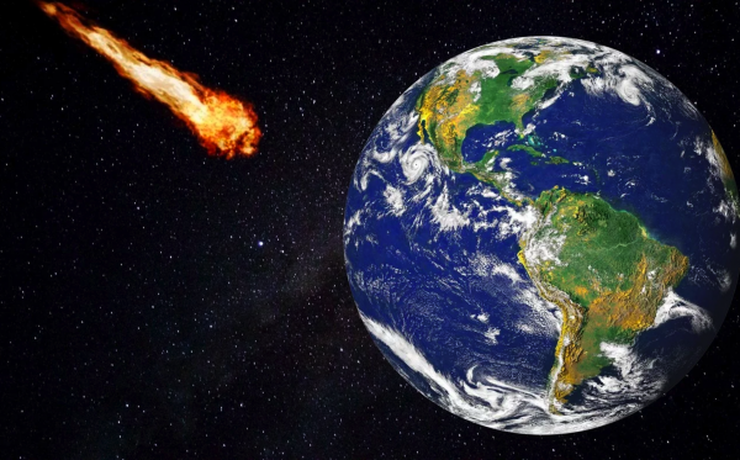|
When the Russians take decisive action, it is usually for a reason. As you will see below, the Russians have suddenly decided that now is the time to create an organization that will be tasked with detecting, tracking and potentially destroying incoming asteroids. Are they doing this now because they have finally decided that this is a good idea, or has something gotten their attention? Of course they are not likely to publicly admit if they have come to the conclusion that a gigantic space rock is heading directly toward us. Just like the U.S. government, the Russian government is very interested in maintaining social order, and so they would probably delay telling the public about a potential asteroid impact for as long as possible. In life, what people do is far more important than what they say, and the new center that the Russians have just created will not just be watching giant space rocks. According to Futurism, this new organization will be in charge of making sure “they don’t collide with Earth”… Russian space agency Roscosmos is creating a center devoted to monitoring meteors, comets, and asteroids to ensure they don’t collide with Earth — even it means having to blow them up in space. Certainly nobody can fault the Russians for allocating resources toward this purpose. Our solar system is full of potentially dangerous giant space rocks, and a big enough impact could literally end our civilization. But why now? According to a British news source, this new organization will be evaluating whether it is better “to destroy celestial objects or steer them on to new trajectories and away from Earth”… Roscosmos, the Russian equivalent of Nasa, wants to work out if it’s possible to destroy celestial objects or steer them on to new trajectories and away from Earth. Once again, nobody can argue with the value of such a major project, but isn’t NASA already doing all this? Couldn’t the Russians just sit back and let us Americans do all the work? I wish someone would ask Vladimir Putin that question. And this sudden move by the Russians comes just one year after the U.S. issued a “National Near-Earth Object Preparedness Strategy and Action Plan”… In 2018, The White House Office of Science and Technology Policy released a new report titled the “National Near-Earth Object Preparedness Strategy and Action Plan”. Maybe U.S. officials suddenly decided last year that having a plan for incoming giant space rocks was a great idea, and maybe the Russians decided that it was such a great idea that they should copy us. Or maybe both governments know something that they aren’t telling us yet. Of course the truth is that NASA has not even identified most of the giant space rocks that are floating around out there. For example, back in July a very large asteroid came very close to hitting us… A 427-foot-wide asteroid whizzed within 45,000 miles of Earth on Thursday. If that asteroid had actually hit our planet, it would have been the worst disaster that any of us have ever seen by a very wide margin. And according to leaked emails, officials at NASA only knew about it the day before it whizzed by us… Traveling at 55,000mph and measuring 426 feet by 187ft (130m x 57m), NASA only realised 2019 OK was coming 24 hours before it passed. So the truth is that we could be hit by a giant space rock at any time, and none of us may have any idea that it is even coming. With that being said, there are a couple of enormous asteroids that scientists do know about that could potentially be major problems over the next decade. The first one that I want to discuss is 2007 FT3. That is not a fancy name, and not that much is known about the asteroid, but apparently there is a chance that it “might hit the planet on Oct. 2, 2024”… In the case of 2007 FT3, Sentry reported that the asteroid could hit Earth between the years 2024 and 2116. During these years, Sentry recorded a total of 164 potential Earth impacts caused by the asteroid. As noted by the monitoring system, there’s a chance that 2007 FT3 might hit the planet on Oct. 2, 2024. By the way, Rosh Hashanah begins on the evening of October 2nd, 2024. I don’t know if that is important, but I thought I would throw that out there. According to NASA, this asteroid would hit at a speed of approximately 46,000 miles per hour, and it would “create a crater that’s several miles long”… Based on the data collected by Sentry, the asteroid has an estimated diameter of about 1,115 feet, which makes it almost as tall as the Empire State Building. The monitoring system noted that it could breach Earth’s atmosphere and hit the planet at a velocity of around 46,000 miles per hour. 2007 FT3 is not getting much publicity at all, but a slightly larger asteroid that could potentially hit us in 2029 is getting far more attention. On April 13th, 2029, it is being projected that Apophis will pass by our planet at a distance that is “ten times closer than the moon”. The following comes from Wikipedia… The closest known approach of Apophis comes on April 13, 2029, when the asteroid comes to within a distance of around 31,000 kilometres from Earth’s surface. The distance, a hair’s breadth in astronomical terms, is ten times closer than the moon, and even closer than some man-made satellites.[23] It will be the closest asteroid of its size in recorded history. On that date, it will become as bright as magnitude 3.1[22] (visible to the naked eye from rural as well as darker suburban areas, visible with binoculars from most locations).[24] The close approach will be visible from Europe, Africa, and western Asia. During the approach, Earth will perturb Apophis from an Aten-class orbit with a semi-major axis of 0.92 AU to an Apollo-class orbit with a semi-major axis of 1.1 AU. NASA insists that it will not actually hit us, but other independent researchers are skeptical. And if Apophis doesn’t hit us then, NASA has listed ten other future dates when it potentially could…
Over in Russia, they are so concerned about this asteroid that they have “developed intercontinental ballistic missiles that aim to destroy asteroid Apophis”… In what sounds like an elevator pitch for an Armageddon sequel, Russian scientists announced that they’ve developed intercontinental ballistic missiles that aim to destroy asteroid Apophis, which is going to swing by Earth in 2036. Russian scientists have also warned that Apophis could have “hundreds of opportunities to hit the Earth over the course of the next century”. But for now, both American and Russian scientists are assuring us that everything is just fine and that there is no reason to panic. Do you believe them? Maybe they are telling us the truth. Maybe there is nothing to be concerned about at all. But of course both governments have a long track record of being loose with the truth, and it wouldn’t be much of a surprise at all if they weren’t exactly being straight with us. Video Description: It’s the year 2028, and we've been carefully monitoring a worrying situation: an enormous asteroid is en route to strike Earth, although the exact point of impact is not yet clear.
National governments are planning to evacuate millions of people, an undertaking that will cause untold human misery and disruption on a gigantic scale. If the asteroid’s impact zone can be fixed, perhaps such chaos can be avoided. As precious hours pass, find out how our Planetary Defence Office is able to obtain crucial information on this potential disaster as part of the Agency’s Space Safety and Security activities. Back to the present day: Find out more about how we are preparing to protect our pale blue dot, its inhabitants and the vital satellite systems on which we have become so dependent. Space Safety & Security at ESA: www.esa.int/spacesafety Planetary Defence: www.esa.int/planetarydefence
0 Comments
Your comment will be posted after it is approved.
Leave a Reply. |
News Watch
Mind-opening news articles, editorials, videos & apparel that inspire our readers and help liberate them from the status quo. Stay informed.
Write For UsSpace WatchTop NewsNews Watch Categories
All
|
|
|
HAVE A TIP OR STORY TO TELL? JOIN TODAY & SHARE YOUR STORY!
If you have a breaking news tip or idea, please email: [email protected] Apparently Apparel® is a registered trade name and part of the ZOAT International® brands network. © 2007-2023. All Rights Reserved. Privacy Policy. All art & news content posted on this site is commentary or opinion and is protected under Free Speech. ApparentlyApparel.com is not responsible for content written by contributing artists, authors or news feeds. The information on this site is provided for educational and entertainment purposes only. It is not intended as a substitute for professional advice of any kind. ApparentlyApparel.com assumes no responsibility for the use or misuse of this material.
|
|










